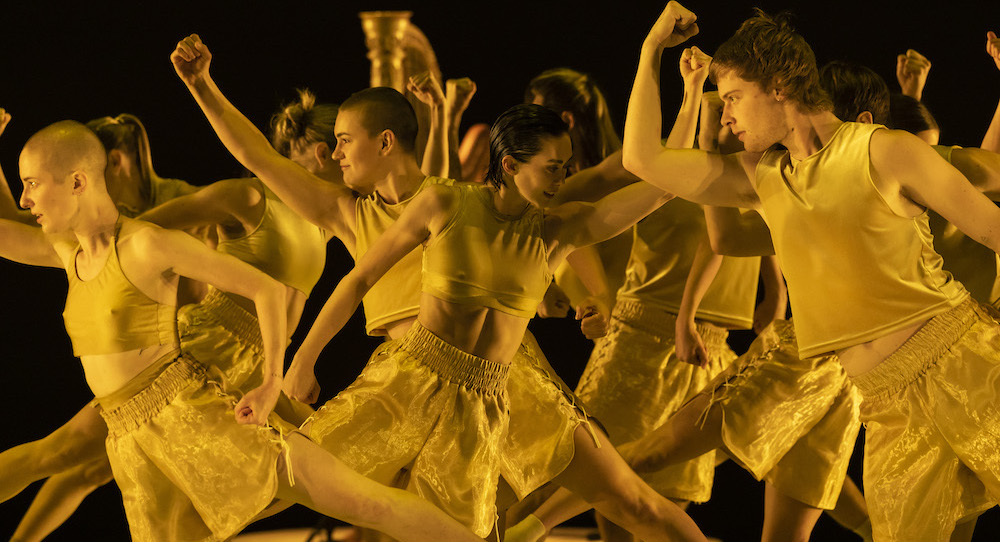Roslyn Packer Theatre, Sydney.
29 October 2022.
Sydney Dance Company’s Resound is a challenging, thought-provoking triple bill that showcases the superlative dancing of the Sydney Dance Company dancers in a triple bill blending revivals and new works. Ballet technique is used as a base, but taken, developed and reconstructed at times. Choreographically, at certain points, there are tiny fleeting allusions to both the ‘traditional’ Swan Lake and also Matthew Bourne’s version. The dazzling, streamlined, fluid quality of movement is, at times, rich and luscious, at others, sharp, spiky and staccato.

First came Rafael Bonachela’s Ocho (‘eight’ in Spanish), which was first performed in 2017. There was an atmosphere of loss and separation, yet also of togetherness – enforced togetherness with no freedom to move freely. There is a glass walled room with a sliding door that the eight dancers emerge from at various points, or are trapped behind (set design by David Fleischer). Nick Wales’s score throbs and crackles and includes the haunting vocals of Aboriginal artist Rrawun Maymuru, complimented by Damien Cooper’s stark yet atmospheric lighting. The dancers form pairs, trios and unison ensembles both inside and out. Luke Hayward and Chloe Leong in particular deserve special mention. The glass acts not just as a cold barrier but also a reflective surface. There are slow, trapped movements contrasted with slithering floorwork, some softy creamy jumps, whirling turns and long stretches. The dancers’ arms are, at times, circular and wheeling, or form angular shapes. There are some difficult lifts and a writhing sculptural ensemble.
Each dancer is able to escape briefly ‘outside‘ the ominous room to perform a spectacular solo. Toward the end, the dancers outside the room form horizontal then diagonal lines across the stage and conclude the work with fast turns with straight arms as if taking a bow.

Bonachela’s dynamic new work, Summer, is for three dancers, two male one female, and utilises a resonant, insistent score, Cicadidae by Australian composer Kate Moore, recorded by the Australian String Quartet. Damien Cooper’s lighting again is splendid. Apologies, but I did not like the vibrant, brightly multi-coloured patchwork looking unitards the dancers wore as designed by Romance Was Born.
The trio of dancers are in constant movement – pantherine leaps, sinuous ripples, wheeling turns and jumps. Sometimes, the dancers are tightly together or sculpturally enfolding and entwining. Arms are at times strong and stretched, but toward the end, they are almost flying and undulating like coral.
After interval came Stephanie Lake’s The Universe is Here with solo harpist Emily Granger softly playing centre stage, on a plinth, bathed in orange light. The music delicately cascades and glints. Slowly, the dancers emerge from the gloom (there are 14 of them) and walk toward us in a line, with repeated small movements and undulating arms then form a whirling circle. They are all in gold shorts with an individual assortment of coordinated tops as designed by Harriet Oxley. Eventually, both the music and dancers get faster and faster.

Crash! A thunderstorm hits.
There are crackling sounds from Robin Fox’s piercing, driven score with the dancers executing some spectacular, creamy, very controlled solos that then erupt into far more loose and expressive segments. For the ensemble, arms are at one point held on the shoulders with a butt wiggle, or hands held in front as if they were boxing, flickering fingers, including sexy walks with a pelvic thrust. (Some of it seemed quite buoyant Mardi Gras dancing, darling.)
Suddenly, a vey quick blackout and the back of the set is covered except for Granger on the harp. This is followed by some short snippets of duets and an aching yearning solo. The ensemble then swarm back on with rolling floorwork then slip, slide, run. Included also are some very difficult partnering lifts and group sculptural writhing. They form lines and fall into one another. They disappear behind the curtain; the shadows are most important. The curtain is torn down, and the dancers strut and turn like models as they walk to the centre of the front of the stage while Granger plays.
Movements are repeated, and there is panting and silent mouthing. Quirky walks and shakes, crouches and jabs are contrasted with tender intimate interactions that range from luscious and creamy to apprehensive and skittish.
Memorable performances were given by Luke Hayward and Jesse Scales, as well as Jacopo Grabar, Rhys Kosakowski, Mia Thompson and Chloe Young.
The work manifests Lake’s interwoven motifs of enigmas and differences, artistry and melancholy.
Mention should perhaps be made that strobe lighting and other flickering light effects are used at times in all three works, as well as stage fog.
Resound is a most intriguing triple bill.
By Lynne Lancaster of Dance Informa.

















